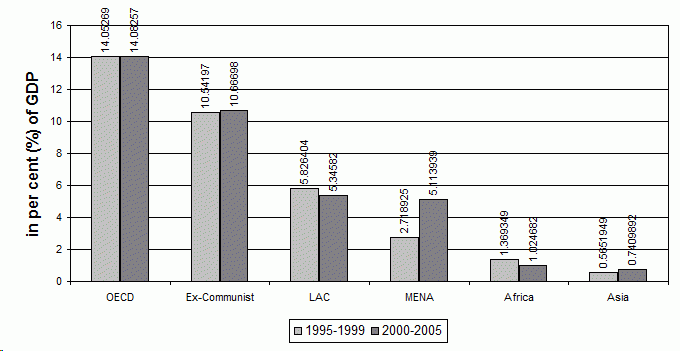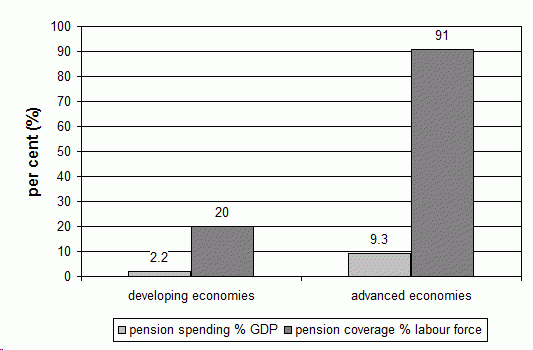Social security serves many purposes for individuals, businesses, and the state. It helps individuals to smooth consumption over the life cycle and during macroeconomic downturns, it facilitates job mobility and job matching, it supports human capital formation for long-term growth and, by acting as an automatic stabiliser, it facilitates economic stability (Townsend 2009). If well-designed, social security spending does not only address immediate needs but can also translate into better crisis preparedness and better social policy in the future (Islam and Chowdry 2010).
Social policy born out of crisis
Looking historically, crises have played defining roles in developing and strengthening social security policy. Social security regimes have often been born out of crisis. For instance the German social insurance model responded to a social crisis or social threat, the British Beveridge model responded to the emerging social crisis looming from World War II, and the American Social Security Act responded to the social crisis of the Great Depression.
Trends in social security spending
Figure 1 shows a wide regional variations in social security spending, with OECD countries spending the most on average, followed by former communist countries (ex-Communist), Latin American countries (LAC) and Middle Eastern and North African Countries (MENA), and finally African and Asian countries.
In general, social security includes any social insurance or social assistance scheme that protects people from certain economic shocks or risks. We define total social security spending in line with the IMF’s definition of social protection (IMF 2001).
Figure 1. Trends in spending on social security by region (% of GDP)
Source: Estimates based on IMF 2007 Global Finance Statistics and Global Development Network Growth Database, GDP from World Development Indicators 2008, OECDStat for OECD countries, ADB Key Indicators for Asian countries.
Pension coverage
The bulk of the social security spending is comprised of pension spending. On average, developing economies spend 2.2% of GDP on pensions, while the developed economies spend 9.3% (see Figure 2). In developed economies, Italy and Austria spend 15%, while Ireland has the lowest expenditure levels at 3.4%. Among developing economies, Latin American countries are high spenders. Brazil, Uruguay, Argentina – pioneers in social security provision in the region dedicate – spend 13%, 10%, 8% of GDP respectively. In Asia, Malaysia devotes 6.5% of GDP to pensions, China 2.7%, and India only 2%. The rest of the developing world spends less than 5% of GDP while sub- Saharan Africa spends the least at 0.7%.
Figure 2. Pension spending and coverage
Source: World Development Indicators (2009).
In general pension spending and pension coverage is strongly correlated with income levels. As a country’s income level increases so does pension spending. In the developing countries, only 20% of the labour force on average is covered by a pension system compared to 91% in the advanced countries. Among the developing countries, Latin American countries have the highest pension coverage with over 50% of coverage while sub-Saharan African countries have only 5% of coverage. Depending on the coverage rate, pensions can help in reducing poverty through a strong redistributive mechanism. In the advanced countries, more than half of the redistributive impact of social transfers comes from pension benefits (and even over 80% in Switzerland and 70% in Germany) (Mahler and Jesuit 2006). In the EU, social transfers other than pensions (such as unemployment, family and housing benefits) reduce the risk of poverty by 36% (from 25% to 16%) (EU 2009).
In Latin America and most developing economies, social transfers are mostly captured by the richer population, as most of the poor are in the informal sector of employment and are not included in any social protection scheme (Lindert et al. 2006, United Nations 2006). This is expected since richer formal sector workers contribute to social insurance programmes and thus are eligible for the benefits. In the region, social assistance spending is progressive, with about 26% of the social assistance transfers go to the poorest 20%. However, social assistance outlays only constitute 1% of the GDP, while the other 6.3% of GDP spent on social transfer programmes goes to the social insurance (pension and unemployment insurance). This low level of public spending per person implies that the impact on inequality and poverty will be minimal.
Social spending increases in the aftermath of crisis
Data presented in our paper (Prasad and Gerecke 2010) shows that social security spending generally increases during and after a crisis. During a crisis, average un-weighted global spending on social security increases, changing from 6.3% of national GDP for the three years before a crisis, to 6.7% during the crisis year and finally to 6.8% for the three years following a crisis. The relative share of spending on social security also increases, with the unweighted global average moving from 20.8% of total expenditure before a crisis to 21.6% during a crisis year, and finally to 22.3% for the three years following a crisis.
Figure 3. Social security spending as a percentage GDP by region: before, during and after a financial crisis
Source: Estimates based on IMF 2007 Global Finance Statistics and Global Development Network Growth Database, GDP from World Development Indicators 2008, OECDStat for OECD countries, ADB Key Indicators for Asian countries.
Figure 4. Social security spending as a percentage of total expenditure by region: before, during and after a financial crisis
Source: Estimates based on IMF 2007 Global Finance Statistics and Global Development Network Growth Database, GDP from World Development Indicators 2008, OECDStat for OECD countries, ADB Key Indicators for Asian countries.
In the 11 African countries for which we have data, on average social security spending dips during the crisis year, but then surpasses its former level both as a share of GDP (1.0%, 0.9%, 1.4%) and of total expenditure (3.4%, 3.2%, 4.4%). Post-crisis social security spending (% GDP, % total expenditure) surpassed pre-crisis levels in Burundi, Liberia, Madagascar, Togo and Zimbabwe. The share of the budget dedicated to social security spending more than doubled in both Togo (growing by 150%) and Zimbabwe (growing by 116%). Post-crisis social security spending fell lower than pre-crisis levels in Mali, Democratic Republic of the Congo and Zimbabwe; its share of the budget fell by 42.5% and 98% in Mali and Democratic Republic of the Congo, respectively.
In the four Asian developing countries for which we have data, average unweighted social security spending spiked during the crisis year, increasing from 2.2% of GDP pre-crisis to 2.9% in the crisis year and then falling to 2.3% post-crisis; its share of total expenditure fell, moving from 9.2% to 9.0% and finally to 8.3% over the same period. Large variation is seen among the countries, with the share of budget dedicated to social security expanding by 91.6% in Thailand (pre-crisis to post-crisis) and contracting by 38.3% in Sri Lanka.
In other regions of the developing world, average social security spending steadily increased over the pre-crisis, crisis and post-crisis periods. It grew both as a share of GDP (at 4.96%, 5.47%, 5.67% in LAC and at 4.16%, 4.44%, 4.59% in the MENA and as a share of total expenditure (at 23.0%, 24.2%, 25.9% in LAC and at 10.1%, 11.9%, 12.5% in MENA. On a country-by-country basis, post-crisis social security spending surpassed pre-crisis levels in about half of each region’s countries: Bolivia, Brazil, Chile, Costa Rica, Dominican Republic, Panama and Uruguay in LAC and Iran, Kuwait and Tunisia in MENA. Post-crisis social security spending was lower than pre-crisis levels in the other half: Argentina, Colombia, Jamaica, Mexico, Paraguay and Venezuela in LAC and Egypt and Syria in MENA. Marked growth in the share of budget dedicated to social security was seen in Brazil (by 46.6%), Costa Rica (by 74.8%), Dominican Republic (by 98.7%), Iran (by 56.8%), Kuwait (by 44.1%), and Panama (by 67.2%). Marked contraction was seen in Syria (by 51.6%) and Venezuela (by 33.9%).
Conclusion
The crisis presents an opportunity for developing countries to introduce or improve their weak or nonexistent social security and expand on their limited capacity for information-gathering and programme evaluation. Crises also allow countries to reduce or remove ineffective policies in favour of equitable ones that promote long-term growth and better risk management. In the past, many countries have capitalised on this opportunity and successfully exited from their crises while also improving their policy frameworks in the long term.
During this crisis, what is needed is Keynesian-style counter-cyclical fiscal policy, with a particular emphasis on social spending. For the 40%-50% of developing countries without any social safety net programmes, the crisis presents an opportunity for improvement and expansion. Introducing automatic stabilisers, such as unemployment insurance and social assistance, will benefit countries by mitigating the worst effects of the crisis in the short term and improving crisis preparedness in long term.
References
EU (2009), Joint Report on Social Protection and Social Inclusion.
International Labour Organization (ILO) (2008), “Can Low-income Countries Afford Basic Social Security?”, Social Security Policy Briefings Paper 3, International Labour Office, Social Security Department.
IMF (2001), Government Finance Statistics Manual 2001.
Islam I and C Chowdhury (2010), “Managing macroeconomic risks and protecting the vulnerable”, VoxEU.org, 15 August.
Gough, I and G Wood (eds.) (2004), Insecurity and Welfare Regimes in Asia, Africa and Latin America: Social Policy in Development Contexts, Cambridge University Press.
Lindert, K, E Skoufias, and J Shapiro (eds.) (2006), Redistributing Income to the Poor and the Rich: Public Transfers in Latin America and the Caribbean, Social Protection Discussion Paper, 0605, Social Safety Nets Primer Series, World Bank.
Mahler, VA and DK Jesuit (2006), “Fiscal Redistribution in the Developed Countries: New Insights from the Luxembourg Income Study”, Socio-Economic Review, 4(3): 483.
Prasad, Naren and Megan Gerecke (2010), “Social policy in times of crisis”, Global Social Policy, 10(2):218-247, August.
Townsend, P (ed.) (2009), Building Decent Societies: Rethinking the Role of Social Security in Development, Palgrave Macmillan/ILO.
United Nations (2006), Social Panorama of Latin America 2005. Santiago: CEPAL.







